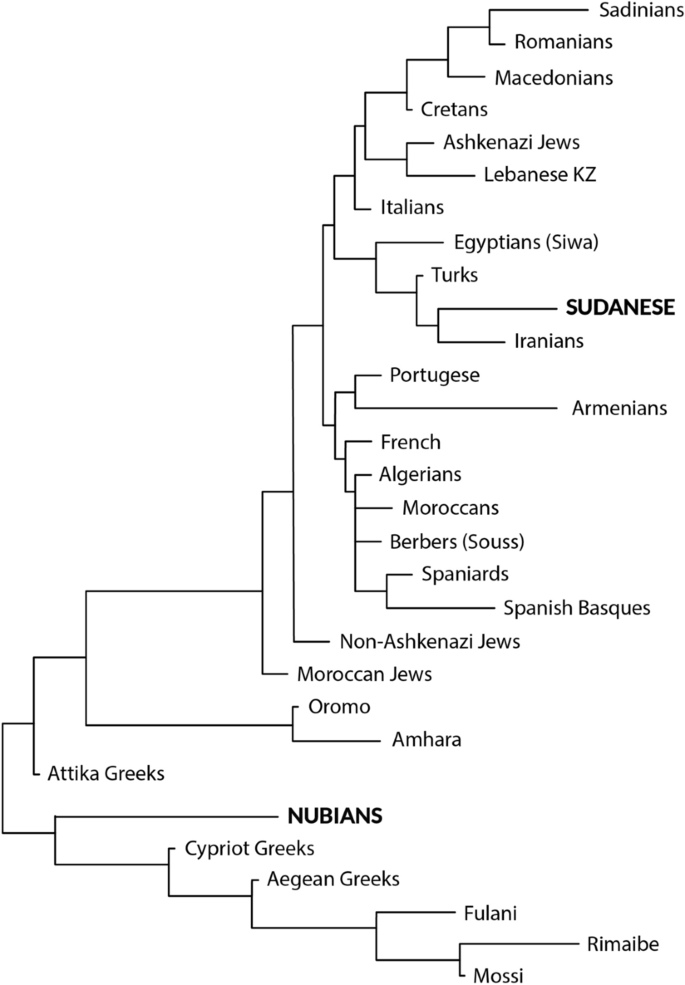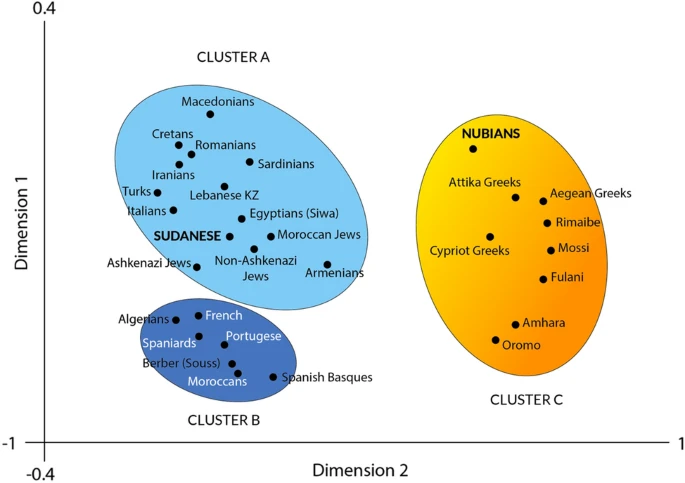real expert
Regular Member
- Messages
- 795
- Reaction score
- 455
- Points
- 63
Afrocentrists are now using this study to validate their claims that the original Greeks were black.
HLA alleles and haplotypes in Sudanese population and their relationship with Mediterraneans - Fabio Suarez‑Trujillo...Antonio Arnaiz‑Villena
September 2023
Below from the article,
some results on the Sudanese as compared Nubian Sudanese in particular (also in the cluster chart, Figure 3, the blue oval shows non-Nubian Sudanese of the study showing close proximity to Jews and Siwa) compare to yellow oval:
HLA alleles and haplotypes in Sudanese population and their relationship with Mediterraneans - Fabio Suarez‑Trujillo...Antonio Arnaiz‑Villena
September 2023
Below from the article,
some results on the Sudanese as compared Nubian Sudanese in particular (also in the cluster chart, Figure 3, the blue oval shows non-Nubian Sudanese of the study showing close proximity to Jews and Siwa) compare to yellow oval:
https://www.nature.com/articles/s41598-023-40173-xAbstract
The contribution of migrated people from once green Sahara (about 10,000–6000 years BC) towards Mediterranean area had probably a double effect: both genetic and cultural connections have been described between Western Europe and North Africa. Sudanese populations from different ethnicities have been studied for HLA-A, -B, -DRB1 and -DQB1 antigens by a standard microlymphotoxicity method.
Results found show that Nubians are genetically related with African Sub-Saharan populations and distant from other Sudanese tribes, who are closer to Mediterranean populations than to Sub-Saharan ones. This is concordant with other authors and meta-analysis data. Our present work is, to our knowledge, the first and only one HLA research that studies Sudanese people according to different Sudan ethnic groups: samples were collected before Sudan partition between North and South. A prehistoric genetic and peoples exchange between Africa and the Mediterranean basin may be observed and is supported with the results obtained in this Sudanese HLA study. However, demic diffusion model of agriculture and other anthropological traits from Middle East to West Europe/Maghreb do not exist: a more detailed Sahel and North African countries ancient and recent admixture studies are also being carried out which may clearer explain pastoralists/agriculture innovations origins in Eurafrican Mediterranean and Atlantic façade.
FIGURE 2

HLA-DRB1 dendrogram performed with Neighbour-Joining method showing genetic relatedness between Sudanese, Nubians, and other Mediterranean and Sub-Saharan populations. Genetic distances between populations were calculated with GNKDST software using low-resolution HLA-DRB1 frequencies. Bootstrap test showed values of 100 in all nodes after 1000 replicates.
Note that Greek HLA relatedness with Sahel populations was detected by two independent different groups4,5,16, 28 and it is also supported by other autosomal genetic markers for African and Greeks specifically (3120 + 1 G → A cystic fibrosis marker)29,30. HLA-DRB1 allele frequencies is used because of the best discrimination between populations among HLA loci (more or less relatedness) and the fact that almost all the populations in data bases are HLA-DRB1 typed
Figure 2 depicts a low-resolution class II (DRB1) neighbour-joining (NJ) tree constructed form genetic distances between populations (DA, Table 3). Its topology shows how compared populations cluster in two main branches: in general, western (both North African and Europeans) and other Mediterraneans group together respectively and tend to converge in the same node; in the other branch Greeks and Sub-Saharans tend to cluster together with Nubians, Fulani, Rimaibe and Mossi (as described before in5,1628 and with other genetic markers29,30. Our Sudanese studied group is placed especially close to most western Mediterraneans: North African (Algerians and Moroccans) and Iberians (Table 3). Genetic distance values (Table 3) give quantitative genetic distances and relatedness between populations and show that Turks are the closest to Sudanese population, followed by Egyptian-Bedouins and Iranians. Also, Mediterranean populations like Algerians, Moroccans, Spaniards and Italians are genetically close to Sudanese population studied in present work. Finally, Greeks and Sub-Saharans cluster together and behave as outgroups. In the same way, the correspondence analysis performed show again how Sudanese are placed within the eastern Mediterranean group, which is also related to the western one (Fig. 3). On the other hand, Nubians cluster together with Greeks and other black Sub-Saharan populations included in this work. Genetic distances between Nubians and our Sudanese mixed sample are similar to those among other Sub-Saharans (Oromo and Amhara) and Sudanese (Tables 3 and 4). These results in Greeks have been previously confirmed by different independent research groups and genes (see “Discussion” section).
FIGURE 3

Correspondence analysis performed with HLA-DRB1 allele frequencies of Sudanese sample studied in present work together with those of other Mediterranean and African populations included (see Table 1). Three different clusters are obtained from the analysis: for simplicity, cluster A (light blue), cluster B (dark blue) and cluster C (yellow/orange). Mixed Sudanese population analysed in this study appears together with other Mediterraneans like Turks, Iranians, Egyptians, Italians or Jews in the eastern-Mediterraneans cluster (cluster A, light blue). However, Sub-Saharan Sahelians (Fulani, Rimaibe, Mossi) and Nubians cluster together with Greeks and other African Sub-Saharan populations (cluster C, yellow/orange), as previously obtained by two independent groups4,5,16,28. Correspondence analysis supports the results previously obtained in the genetic distances analysis (DA) (Table 3) and NJ dendrogram (see Fig. 2). Italians have been chosen from North Italy6, a population that usually cluster with northern Balkan Peninsula or Central European groups.
Discussion
Sudanese HLA Mediterranean background
Our present study shows that Sudanese population is related to Mediterraneans like Turks (who are genetically Mediterraneans except because of an Asian “elite” imposed language18), Egyptians, Iranians, Algerians, Italians and Iberians. This is concordant with other North African, Middle East and Iberian HLA compilation study31 by using another methodology (high-resolution HLA typing). On the other hand, Greeks were found initially close to Sahel populations (Rimaibe, Mossi, Oromo, Amhara); it disconcerted us, and an allele-by-allele comparison was carried out between Greeks and Sub-Saharans to finally show that they both share some HLA alleles in common, confirming our phylogenetic results5,16.
It is well established that North Africans and southern Europeans are genetically related, and this may be due to a long lasting circum-Mediterranean cultural and genetic flow particularly during the last glacial peak4,35,36,37,38,39, being a secluded population between European North Ices and Desert. On the basis of our present day genetic and linguistic studies, we have postulated that many people coming from what is nowadays the Sahara Desert started to move towards East, West, North, and also South, being an important part of the primitive people stock of Sumerians, Egyptians, Guanches (Canary Islands), Iberians, Etruscan, Minoans, Anatolians (currently named Turks on only linguistic bases because they show a clear Mediterranean HLA profile)4, Kurds, and other islanders or northern Mediterraneans4,5,18,36,37,38,39. In the present work, HLA genetic background of Sudanese people from different ethnicities is studied, and results obtained in part confirm these North African-Mediterranean peoples (genes) exchange.

